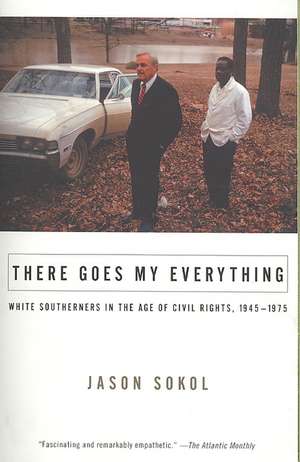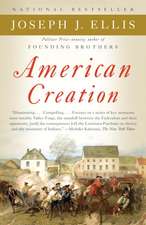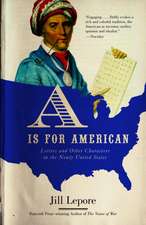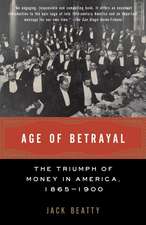There Goes My Everything: White Southerners in the Age of Civil Rights, 1945-1975
Autor Jason Sokolen Limba Engleză Paperback – 31 iul 2007
Preț: 125.43 lei
Nou
Puncte Express: 188
Preț estimativ în valută:
24.00€ • 24.97$ • 19.82£
24.00€ • 24.97$ • 19.82£
Carte disponibilă
Livrare economică 24 martie-07 aprilie
Preluare comenzi: 021 569.72.76
Specificații
ISBN-13: 9780307275509
ISBN-10: 0307275507
Pagini: 433
Ilustrații: 8 PP B&W
Dimensiuni: 134 x 202 x 24 mm
Greutate: 0.42 kg
Editura: Vintage Books USA
ISBN-10: 0307275507
Pagini: 433
Ilustrații: 8 PP B&W
Dimensiuni: 134 x 202 x 24 mm
Greutate: 0.42 kg
Editura: Vintage Books USA
Notă biografică
Jason Sokol grew up in Springfield, Massachusetts, and attended Oberlin College and the University of California, Berkeley, where he received his doctorate in American history. He lives in Ithaca, New York, and teaches at Cornell University.
Extras
ONE
Prelude: In the Wake of the War, 1945-1955
On battlefields in europe and the Pacific, World War II blew gusts of change toward Joe Gilmer and Lewis Barton. For these white soldiers who fought alongside blacks, the war left indelible imprints. "Before the war I had the same feeling towards the Negro as the typical Southerner. God didn't intend them to have equal rights with other races, I thought," Petty Officer Barton wrote in a letter to his hometown newspaper, the Lumberton, North Carolina, Robesonian. By 1945, his belief became one of the war's millions of casualties. "I am afraid that all race prejudice is gone from the boys who have fought this war," Sergeant Gilmer wrote to the Fort Worth Star-Telegram. "White boys who have seen Negroes die to save their 'buddies,' and to help keep America free, are not in favor of the 'Jim Crow' law." In several regiments, by war's end, whites and blacks ate, worked, lived, and fought together. The South's segregation laws seemed petty and absurd by comparison. "Forcing them to ride in the rear of busses and stand for white[s] to sit down, I realize now is narrow-minded childishness practiced by our state," Barton wrote. "I discovered that the Negro is a human being." It was a lesson some white southerners would soon learn. For many others, the humanity of blacks remained a threat of the first order, a fear too immediate to peacefully allow, a reality to indefinitely deny. "It isn't going to be wise for any man . . . to try to abuse the colored people any more," Joe Gilmer warned. "The veterans of this war have learned that freedom means more than just freedom for the white man." Many southern veterans carried this truth back to their communities. The question of the ensuing decade—between the end of World War II in 1945 and the beginning of the Montgomery bus boycott in 1955—was whether white southerners would welcome or challenge it.
Joe Gilmer's and Lewis Barton's transformative experiences placed them in a minority. Many soldiers who fought alongside blacks felt their attitudes change, but they constituted only a small fraction of white southern servicemen. About two-thirds of all white soldiers said blacks should have the same rights after the war as they had before. Many justified their beliefs with assertions like, "We get along fine with the Negro, why change?" and, "They're satisfied with the way they are now." More than 90 percent of white southern soldiers supported separate military facilities and outfits. And white southerners who stayed at home defended segregation even more vehemently. The sight of blacks in uniform had the peculiar ability to spark violence. "It seems that a Negro in uniform has stimulated some white civilians and soldiers to protect the customary caste etiquette of the South," read a 1943 report on the American soldier. That "protection" often manifested itself in the form of racial violence. During the war, the South was the site of six civilian riots, twenty military riots and mutinies, and between forty-five and seventy-five lynchings. While some soldiers felt that interracial contact in the army promoted tolerance, "a larger group seemed to have re-inforced their pre-Army attitudes while in the service. . . . The job done, they wanted to get out, get home, and by and large resume where they had left off." That often meant supporting Jim Crow as staunchly as ever.
Gilmer and Barton both believed their profound wartime experiences were not unique; they thought many white southern soldiers had similar changes in attitudes. Although the testimonies of most whites challenge that generalization, there is some evidence to support it. "All of our servicemen have not reacted in the same way," Guy Johnson said in 1945. Johnson headed the Southern Regional Council, a progressive group—made up of mostly white southerners—that came to support integration. "Some of them have come out with worse attitudes toward the other race than they had when they went in. I believe, however, that the majority of our fighting men have had experiences which have taught them a new appreciation of their fellow Americans of another race." In fact, those with "a new appreciation" for blacks comprised but a small segment. Yet their experiences were significant, and augured larger changes in the years to come.
Before Frank Smith gained notoriety as the rare progressive congressman from the Mississippi Delta, he fought in the army during World War II. What Smith learned at Artillery Officers Training School in Fort Sill, Oklahoma, in 1942 stayed with him for the rest of his life. "OCS at Fort Sill was a revolutionary experience to those of us from the South, and probably to a good many others from outside the South. Negro officer candidates were scattered among us wherever they happened to fall in the alphabetical list." Smith detected little resistance to this policy among southern soldiers. "The Southerners who expressed themselves to me said they had no objections, and some even voiced approval . . . [N]obody was bucking the tide." Southerners who would later oppose segregation, like Smith, often looked back on the war as a turning point. While Smith grew up as a member of the Mississippi Delta's small middle class, Claude Ramsay was raised in poverty across the state in Ocean Springs. Ramsay carried traditional southern beliefs about race into the war. Yet when he returned to civilian life, he began to believe that blacks should have their rights. He landed a job at International Paper Company shortly after the war, and won the presidency of the state AFL-CIO in 1959. For the rest of his life, Ramsay would consider the war a defining experience.
Georgia native Harold Fleming had similar memories of his service as a commander in the Pacific. "It did more to change my life than any other experience I've ever had," Fleming confessed. "I'm a . . . good old boy at heart." He neither sought nor expected any transformation in his racial views, but his war experiences thrust such changes upon him. Stationed in Okinawa, Fleming was placed in charge of African-American troops. "The nearest thing you could be in the army to being black was to be a company officer with black troops," he later told journalist Fred Powledge, "because you lived and operated under the same circumstances they did, and they got crapped all over." This experience did not instantly convert the "good old boy" to political radicalism, but it did open his eyes and change his life. " 'Radicalized' would be too strong a word. It wasn't that I came to love Negroes; it was that I came to despise the system that did this." Fleming completed the transition when he went to work for the SRC after graduating from Harvard. He would eventually lead the organization during the 1950s. Fleming kept few friends from his prewar days; he associated mostly with like-minded progressives and friends from the American Veterans Committee. The committee consisted of "usually young veterans, just back from the war, white and black, who thought there was or ought to be a new day on this race stuff. And I exchanged my old friends for a new set of friends and co-workers and collaborators." After the war, nothing in Harold Fleming's life remained the same. "The army experience activated me," he later recalled; it set him along an arc that reshaped his career, his friendships, and the stuff of his everyday life.
Most southern soldiers' life trajectories were unlike those of Frank Smith, Claude Ramsay, or Harold Fleming. Still, the majority of white southern soldiers who fought alongside blacks found that they "got along well together." A platoon sergeant from South Carolina remembered, "When I heard about it, I said I'd be damned if I'd wear the same shoulder patch they did. After that first day when we saw how they fought, I changed my mind. They're just like any of the other boys to us." Many soldiers confirmed that in combat the color line vanished. "We was trapped behind the line, and white was afraid of dying as blacks," African-American veteran Wilson Evans remembered of the Battle of the Bulge. "And there was no color, no nothing. . . . I did see that Americans could become Americans for about eight or nine days." While these soldiers asserted that race was inconsequential in combat, an overwhelming majority of white southern soldiers still resented the army's integrated living quarters. Combat suspended the color line, but the garrison introduced it again.
Seth Lurie, an air force major from New Orleans, was stationed after the war at Craig Field in rural Dallas County, Alabama. He described himself as "a reconstructed southerner," and attributed that conversion to his military career. "The greatest teacher is experience . . . My education on this came solely from the military." Like Frank Smith, Lurie was housed alphabetically at Officer Training School. In that interracial contact, prejudices centuries in the making dissolved during everyday interaction:
That was my first real contact with Negroes. . . . I learned that a Negro was a human being, with blood in his brain, and perspiration on his brow, with aches the same . . . ambitions the same, thought of home the same. I learned later that he died the same as a white man dies, for the same cause. Also in combat I learned that he has the same courage and daring as a white man. . . . To the best of my knowledge, there is no resentment on the part of any white officer.
Lurie's revelations were powerful. They showed that weeks of experience could undo the received wisdom and ingrained customs of an entire upbringing.
Seth Lurie was quick to realize that his experiences did not suggest a region-wide transformation. He could see it firsthand in his interactions with the residents of nearby Selma. "Old timers in this town are against progress. . . . Until this segregation-preaching generation dies off and a new generation takes hold, there will be trouble." Monumental wartime changes failed to grip all southerners. More than half of the war's veterans predicted "trouble" with blacks, and almost 20 percent foresaw "trouble" with Jews. A 1946 social psychological survey found "little reason for doubting the re-absorption of the vast majority of American soldiers into the normal patterns of American life." White southern soldiers became reabsorbed in the South's traditional way of life. Many believed they had fought to defend, not overturn, racial customs.
While African-American veterans remembered that some white soldiers lost their prejudices in the war, those memories were far outweighed by accounts of whites who violently defended Jim Crow. Dempsey Travis was stationed in Camp Shenango, Pennsylvania, where the only PX excluded blacks. When a black soldier went into the PX for a beer, whites kicked his eye out. Travis joined an expanding crowd of African-American soldiers who discussed what action to take. A caravan of six trucks arrived, and white soldiers jumped off—wearing battle fatigues and carrying arms. They fired into the crowd, hitting Travis in several places. He recalled the ambulance ride: "Two guys were sitting in front. The one says to the driver, 'Why we be doin' this to our own soldiers?' Driver says, 'Who ever told you niggers were our soldiers? Where I come from'—I detected a southern accent—'we shoot niggers like we shoot rabbits.' " By 1943, Travis had been put in charge of a troop movement on its way to Camp Lee, in Richmond, Virginia. It was the first time Travis, a Chicago native, had witnessed the life of the South. Some sights singed his northern eyes. German POWs rode in the front of the city's streetcars, blacks in the back. After Travis received a transfer to Aberdeen, Maryland, in 1945, he came across the rare white southerner who seemed to have been liberated by the war. A major from Texas made Travis manager of an integrated PX. In the end, Travis "found the most sympathetic white men in the army were actually southerners." White southerners were nothing if not diverse: some welcomed blacks; others brimmed with hostility. In the memories of most black soldiers, however, the hostility far surpassed the acceptance.
Alfred Duckett found few sympathetic whites. A freelance journalist who published articles in many of America's major black newspapers, Duckett was drafted and sent to Camp Claiborne, Louisiana. "The first night we arrived, a white officer told us what the rules were. . . . 'We want you to know we're not takin' any foolishness down here, because we don't shoot 'em down here, we hang 'em.' " When Duckett shipped over to Camp Lucky Strike in France, he found "an almost psychotic terror on the part of white commanders that there would be a great deal of association with the white women." The company's chaplain traveled in advance to each town, and informed the locals that blacks had tails. The commander issued an edict that black troops could not associate with French civilians. When Allen Leftridge disobeyed this order and conversed with a French woman who was serving coffee and doughnuts, a white MP shot him in the back. The white officers were so paranoid about black soldiers that they locked up the regiment's guns. Blacks received arms only in combat. As some white southerners clung to the myth of the "happy Negro," many recoiled in terror at the prospect of black men with guns—or even worse, with white women.
When the last battles were over and soldiers became veterans, whites and blacks alike gazed back toward home. Many black soldiers discovered that if their native Southland had begun to grapple with economic and demographic change, little metamorphosis had occurred in white racial attitudes. Ben Fielder, an African-American from Mississippi, served in both Europe and the Far East, and made his way up the ranks to staff sergeant. After returning to the United States, Fielder and a white veteran embarked on a train ride from California back to their native Mississippi. As the train rumbled across the country, the two dined together and passed the time telling stories. Fielder felt they transcended "this race nonsense" and "became tight." When the train passed into Texas and Louisiana, Fielder realized his mistake. The white soldier assumed a posture of superiority, and informed Fielder that the war was over, that they were back in the South, and that, as Fielder recalled, "I was still just a nigger. Not an American soldier anymore. Just a nigger." Black veteran German Levy of Brookhaven, Mississippi, concurred that on the level of white racial behavior, little had changed. "The pancake hadn't turned over . . . you come back home right into the same world you left." In many ways, the South at war's end closely resembled the prewar land. Reconstructed or not, white soldiers made their way back to factories, farms, and families, or moved into growing cities. While these soldiers had seen the wide world, some returned to communities that seemed much the same as before they left. Many preferred it that way.
From the Hardcover edition.
Prelude: In the Wake of the War, 1945-1955
On battlefields in europe and the Pacific, World War II blew gusts of change toward Joe Gilmer and Lewis Barton. For these white soldiers who fought alongside blacks, the war left indelible imprints. "Before the war I had the same feeling towards the Negro as the typical Southerner. God didn't intend them to have equal rights with other races, I thought," Petty Officer Barton wrote in a letter to his hometown newspaper, the Lumberton, North Carolina, Robesonian. By 1945, his belief became one of the war's millions of casualties. "I am afraid that all race prejudice is gone from the boys who have fought this war," Sergeant Gilmer wrote to the Fort Worth Star-Telegram. "White boys who have seen Negroes die to save their 'buddies,' and to help keep America free, are not in favor of the 'Jim Crow' law." In several regiments, by war's end, whites and blacks ate, worked, lived, and fought together. The South's segregation laws seemed petty and absurd by comparison. "Forcing them to ride in the rear of busses and stand for white[s] to sit down, I realize now is narrow-minded childishness practiced by our state," Barton wrote. "I discovered that the Negro is a human being." It was a lesson some white southerners would soon learn. For many others, the humanity of blacks remained a threat of the first order, a fear too immediate to peacefully allow, a reality to indefinitely deny. "It isn't going to be wise for any man . . . to try to abuse the colored people any more," Joe Gilmer warned. "The veterans of this war have learned that freedom means more than just freedom for the white man." Many southern veterans carried this truth back to their communities. The question of the ensuing decade—between the end of World War II in 1945 and the beginning of the Montgomery bus boycott in 1955—was whether white southerners would welcome or challenge it.
Joe Gilmer's and Lewis Barton's transformative experiences placed them in a minority. Many soldiers who fought alongside blacks felt their attitudes change, but they constituted only a small fraction of white southern servicemen. About two-thirds of all white soldiers said blacks should have the same rights after the war as they had before. Many justified their beliefs with assertions like, "We get along fine with the Negro, why change?" and, "They're satisfied with the way they are now." More than 90 percent of white southern soldiers supported separate military facilities and outfits. And white southerners who stayed at home defended segregation even more vehemently. The sight of blacks in uniform had the peculiar ability to spark violence. "It seems that a Negro in uniform has stimulated some white civilians and soldiers to protect the customary caste etiquette of the South," read a 1943 report on the American soldier. That "protection" often manifested itself in the form of racial violence. During the war, the South was the site of six civilian riots, twenty military riots and mutinies, and between forty-five and seventy-five lynchings. While some soldiers felt that interracial contact in the army promoted tolerance, "a larger group seemed to have re-inforced their pre-Army attitudes while in the service. . . . The job done, they wanted to get out, get home, and by and large resume where they had left off." That often meant supporting Jim Crow as staunchly as ever.
Gilmer and Barton both believed their profound wartime experiences were not unique; they thought many white southern soldiers had similar changes in attitudes. Although the testimonies of most whites challenge that generalization, there is some evidence to support it. "All of our servicemen have not reacted in the same way," Guy Johnson said in 1945. Johnson headed the Southern Regional Council, a progressive group—made up of mostly white southerners—that came to support integration. "Some of them have come out with worse attitudes toward the other race than they had when they went in. I believe, however, that the majority of our fighting men have had experiences which have taught them a new appreciation of their fellow Americans of another race." In fact, those with "a new appreciation" for blacks comprised but a small segment. Yet their experiences were significant, and augured larger changes in the years to come.
Before Frank Smith gained notoriety as the rare progressive congressman from the Mississippi Delta, he fought in the army during World War II. What Smith learned at Artillery Officers Training School in Fort Sill, Oklahoma, in 1942 stayed with him for the rest of his life. "OCS at Fort Sill was a revolutionary experience to those of us from the South, and probably to a good many others from outside the South. Negro officer candidates were scattered among us wherever they happened to fall in the alphabetical list." Smith detected little resistance to this policy among southern soldiers. "The Southerners who expressed themselves to me said they had no objections, and some even voiced approval . . . [N]obody was bucking the tide." Southerners who would later oppose segregation, like Smith, often looked back on the war as a turning point. While Smith grew up as a member of the Mississippi Delta's small middle class, Claude Ramsay was raised in poverty across the state in Ocean Springs. Ramsay carried traditional southern beliefs about race into the war. Yet when he returned to civilian life, he began to believe that blacks should have their rights. He landed a job at International Paper Company shortly after the war, and won the presidency of the state AFL-CIO in 1959. For the rest of his life, Ramsay would consider the war a defining experience.
Georgia native Harold Fleming had similar memories of his service as a commander in the Pacific. "It did more to change my life than any other experience I've ever had," Fleming confessed. "I'm a . . . good old boy at heart." He neither sought nor expected any transformation in his racial views, but his war experiences thrust such changes upon him. Stationed in Okinawa, Fleming was placed in charge of African-American troops. "The nearest thing you could be in the army to being black was to be a company officer with black troops," he later told journalist Fred Powledge, "because you lived and operated under the same circumstances they did, and they got crapped all over." This experience did not instantly convert the "good old boy" to political radicalism, but it did open his eyes and change his life. " 'Radicalized' would be too strong a word. It wasn't that I came to love Negroes; it was that I came to despise the system that did this." Fleming completed the transition when he went to work for the SRC after graduating from Harvard. He would eventually lead the organization during the 1950s. Fleming kept few friends from his prewar days; he associated mostly with like-minded progressives and friends from the American Veterans Committee. The committee consisted of "usually young veterans, just back from the war, white and black, who thought there was or ought to be a new day on this race stuff. And I exchanged my old friends for a new set of friends and co-workers and collaborators." After the war, nothing in Harold Fleming's life remained the same. "The army experience activated me," he later recalled; it set him along an arc that reshaped his career, his friendships, and the stuff of his everyday life.
Most southern soldiers' life trajectories were unlike those of Frank Smith, Claude Ramsay, or Harold Fleming. Still, the majority of white southern soldiers who fought alongside blacks found that they "got along well together." A platoon sergeant from South Carolina remembered, "When I heard about it, I said I'd be damned if I'd wear the same shoulder patch they did. After that first day when we saw how they fought, I changed my mind. They're just like any of the other boys to us." Many soldiers confirmed that in combat the color line vanished. "We was trapped behind the line, and white was afraid of dying as blacks," African-American veteran Wilson Evans remembered of the Battle of the Bulge. "And there was no color, no nothing. . . . I did see that Americans could become Americans for about eight or nine days." While these soldiers asserted that race was inconsequential in combat, an overwhelming majority of white southern soldiers still resented the army's integrated living quarters. Combat suspended the color line, but the garrison introduced it again.
Seth Lurie, an air force major from New Orleans, was stationed after the war at Craig Field in rural Dallas County, Alabama. He described himself as "a reconstructed southerner," and attributed that conversion to his military career. "The greatest teacher is experience . . . My education on this came solely from the military." Like Frank Smith, Lurie was housed alphabetically at Officer Training School. In that interracial contact, prejudices centuries in the making dissolved during everyday interaction:
That was my first real contact with Negroes. . . . I learned that a Negro was a human being, with blood in his brain, and perspiration on his brow, with aches the same . . . ambitions the same, thought of home the same. I learned later that he died the same as a white man dies, for the same cause. Also in combat I learned that he has the same courage and daring as a white man. . . . To the best of my knowledge, there is no resentment on the part of any white officer.
Lurie's revelations were powerful. They showed that weeks of experience could undo the received wisdom and ingrained customs of an entire upbringing.
Seth Lurie was quick to realize that his experiences did not suggest a region-wide transformation. He could see it firsthand in his interactions with the residents of nearby Selma. "Old timers in this town are against progress. . . . Until this segregation-preaching generation dies off and a new generation takes hold, there will be trouble." Monumental wartime changes failed to grip all southerners. More than half of the war's veterans predicted "trouble" with blacks, and almost 20 percent foresaw "trouble" with Jews. A 1946 social psychological survey found "little reason for doubting the re-absorption of the vast majority of American soldiers into the normal patterns of American life." White southern soldiers became reabsorbed in the South's traditional way of life. Many believed they had fought to defend, not overturn, racial customs.
While African-American veterans remembered that some white soldiers lost their prejudices in the war, those memories were far outweighed by accounts of whites who violently defended Jim Crow. Dempsey Travis was stationed in Camp Shenango, Pennsylvania, where the only PX excluded blacks. When a black soldier went into the PX for a beer, whites kicked his eye out. Travis joined an expanding crowd of African-American soldiers who discussed what action to take. A caravan of six trucks arrived, and white soldiers jumped off—wearing battle fatigues and carrying arms. They fired into the crowd, hitting Travis in several places. He recalled the ambulance ride: "Two guys were sitting in front. The one says to the driver, 'Why we be doin' this to our own soldiers?' Driver says, 'Who ever told you niggers were our soldiers? Where I come from'—I detected a southern accent—'we shoot niggers like we shoot rabbits.' " By 1943, Travis had been put in charge of a troop movement on its way to Camp Lee, in Richmond, Virginia. It was the first time Travis, a Chicago native, had witnessed the life of the South. Some sights singed his northern eyes. German POWs rode in the front of the city's streetcars, blacks in the back. After Travis received a transfer to Aberdeen, Maryland, in 1945, he came across the rare white southerner who seemed to have been liberated by the war. A major from Texas made Travis manager of an integrated PX. In the end, Travis "found the most sympathetic white men in the army were actually southerners." White southerners were nothing if not diverse: some welcomed blacks; others brimmed with hostility. In the memories of most black soldiers, however, the hostility far surpassed the acceptance.
Alfred Duckett found few sympathetic whites. A freelance journalist who published articles in many of America's major black newspapers, Duckett was drafted and sent to Camp Claiborne, Louisiana. "The first night we arrived, a white officer told us what the rules were. . . . 'We want you to know we're not takin' any foolishness down here, because we don't shoot 'em down here, we hang 'em.' " When Duckett shipped over to Camp Lucky Strike in France, he found "an almost psychotic terror on the part of white commanders that there would be a great deal of association with the white women." The company's chaplain traveled in advance to each town, and informed the locals that blacks had tails. The commander issued an edict that black troops could not associate with French civilians. When Allen Leftridge disobeyed this order and conversed with a French woman who was serving coffee and doughnuts, a white MP shot him in the back. The white officers were so paranoid about black soldiers that they locked up the regiment's guns. Blacks received arms only in combat. As some white southerners clung to the myth of the "happy Negro," many recoiled in terror at the prospect of black men with guns—or even worse, with white women.
When the last battles were over and soldiers became veterans, whites and blacks alike gazed back toward home. Many black soldiers discovered that if their native Southland had begun to grapple with economic and demographic change, little metamorphosis had occurred in white racial attitudes. Ben Fielder, an African-American from Mississippi, served in both Europe and the Far East, and made his way up the ranks to staff sergeant. After returning to the United States, Fielder and a white veteran embarked on a train ride from California back to their native Mississippi. As the train rumbled across the country, the two dined together and passed the time telling stories. Fielder felt they transcended "this race nonsense" and "became tight." When the train passed into Texas and Louisiana, Fielder realized his mistake. The white soldier assumed a posture of superiority, and informed Fielder that the war was over, that they were back in the South, and that, as Fielder recalled, "I was still just a nigger. Not an American soldier anymore. Just a nigger." Black veteran German Levy of Brookhaven, Mississippi, concurred that on the level of white racial behavior, little had changed. "The pancake hadn't turned over . . . you come back home right into the same world you left." In many ways, the South at war's end closely resembled the prewar land. Reconstructed or not, white soldiers made their way back to factories, farms, and families, or moved into growing cities. While these soldiers had seen the wide world, some returned to communities that seemed much the same as before they left. Many preferred it that way.
From the Hardcover edition.
Recenzii
“Fascinating and remarkably empathetic.” —The Atlantic Monthly“[There Goes My Everything is] on my personal list of the year’s best books.” —Jonathan Yardley, The Washington Post “A richly documented, often compellingly dramatic narrative, whose strength is its absence of polemic.” —Dallas Morning News"As eye-opening a look at race relations in the Civil Rights Era as anything this side of Dr. King's own Letter From a Birmingham Jail."—Arkansas Democrat-Gazette“Simply stunning…This is one of the few books about the civil rights movement…that gets it right…Deserves to be read by every American.” —Tucson Citizen



















